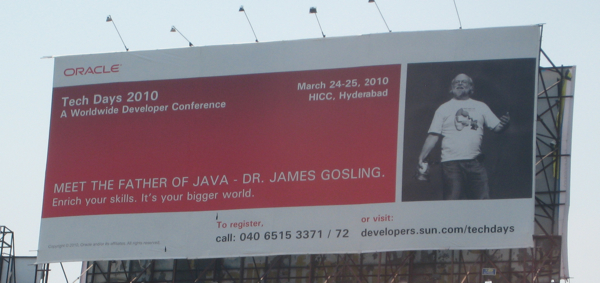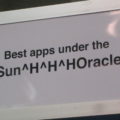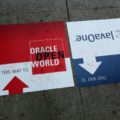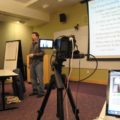(Part 4 of Resistance is Futile: The Oracle Acquisition)
The “change in control” from Sun to Oracle took place, in the US, on Feb 15, 2010. I visited the Oracle campus in Redwood Shores that day, invited by one of Oracle’s few sanctioned social media experts. As it happened, that was also the day that an Oracle support employee, wildly popular with customers for giving out support advice for free on Twitter and in a blog, was being shut down by the company, forbidden to provide answers outside the official – paid – support channels. It was clear that I wasn’t in Kansas anymore.
Soon thereafter, I was in Menlo Park for team meetings when I discovered that dozens of my videos had been deleted, without warning, from the BTV video hosting platform that had just been rebranded as Oracle’s. My colleagues heard my screams of anguish. I had not archived copies of those videos; that person in charge of Oracle media had not told me they would be removed (I rather thought she had implied that they would simply be rebranded). She gave no reason for the removal, and turned a deaf ear to my pleas that these were useful and perhaps irreplaceable original material, technologists talking about technology. The videos were still on a server somewhere, but I was never able to get a single one reposted. I hope there’s a special hell reserved for those who deliberately and maliciously destroy others’ work.
Her attitude was all too typical of what we experienced across Oracle, both at the corporate level and from many individuals. Oracle had been on an acquisitions spree, buying 50+ companies in five years and assimilating them with brutal efficiency. As far as I could tell, Oracle had no notion that it had once had its own corporate culture that might be worth preserving, let alone care that any of its targets did. That summer I met a former Oracle employee who had quit 18 months earlier, after 12 years with the company. “I didn’t recognize it anymore,” he said sadly. “After all the acquisitions began, it was no longer the Oracle I used to know and love.”
It was made very clear to us all that we were cogs in the machine and should not think too highly of ourselves. The only thing that mattered was profit, which was arrived at by carefully orchestrated process. Time after time we were told: “This is how it’s done here, get used to it” – sometimes in those very words. I had the impression that some victims of earlier acquisitions positively enjoyed putting us uppity Sun folk through the same miseries that they themselves had endured. Cherished ways and systems that had persisted for years at Sun – usually because they worked – were swept away with no regard for anything except The Rules.
Some particularly process-oriented former Sun people thrived in the new regime; most of us did not. For better and for worse, Sun’s creative, anarchic culture was the polar opposite of Oracle’s command-and-control style. It was soon clear that many of us, despite our best intentions to keep open minds and try to stand by the people and technologies we loved working with, would not be long for the Oracle world.
I have to hand it to Oracle: they were very canny about layoffs. Larry Ellison had claimed that “fewer than 1000” of Sun’s 30,000 employees would be laid off at acquisition. This was true – in north America. The change in control in other regions took place weeks or months later for various legal reasons, and many more layoffs happened in those areas, unnoticed by the US media. In some regions, salaries were simply cut so steeply (to match Oracle’s local salary ranges) that people left for other jobs as soon as they could find them.
I suspect that Oracle also skillfully identified the Sun employees to whom they didn’t need to offer layoff packages, because they would obviously quit anyway. In the cases of some that Oracle might have liked to keep, at least as figureheads, any desire to do so was apparently outweighed by Oracle’s structures, processes, and culture. I’ve heard that some special offers were later made to try to stem the exodus of talent, but it doesn’t seem to have worked in most cases.
The first high-profile departure (post-Oracle) was James Gosling, the father of Java, who resigned in April, soon after headlining one of the last Sun Tech Days events, in Hyderabad, India. This also happened to be my last major trip for Sun/Oracle. I had never met Gosling (saw him once in an elevator), but was surprised at how withdrawn and standoffish he seemed in Hyderabad, spending most of his free time huddled in the hotel restaurant.
I returned to the US, finished packing my few possessions in Colorado into my Toyota Rav4, then drove to San Francisco, all within the space of five days, arriving and moving into my new home on April 3, 2010. I didn’t have official permission from Oracle to change my place of employment, but back in January I had had a major meltdown on the phone with my manager. The proximate cause was huge tensions with my Colorado roommate before the acquisition layoffs were finalized (in the event, all three of us in the household survived them). I needed to get out of that house, but it didn’t make sense to sign a lease elsewhere in Colorado when I was ready to move to California anyway. Lynn finally said: “Go ahead and go, we’ll make it official later.” She couldn’t give me a moving allowance or the cost-of-living raise that I would have got if I’d moved with Sun before the acquisition process began – Oracle doesn’t do that kind of thing. Of course.
- Part 1: Resistance is Futile: The Oracle Acquisition
- Part 2: What to Expect When You’re Expecting – to Be Acquired
- Part 3: Fishworks and Me
- Part 4: Into the Belly of the Beast
- Part 5: The Last of OpenSolaris
- Part 6: Diaspora (not yet written)
- The 3rd Annual Solaris Family Reunion
- Part 7: Letting Go of a Beloved Technology





